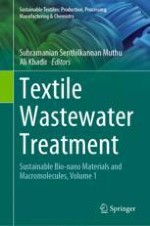
2022 | OriginalPaper | Chapter
Textile Industry: Pollution Health Risks and Toxicity
Authors : Tasneem Sarwar, Sardar Khan
Published in: Textile Wastewater Treatment
Publisher: Springer Nature Singapore
Activate our intelligent search to find suitable subject content or patents.
Select sections of text to find matching patents with Artificial Intelligence. powered by
Select sections of text to find additional relevant content using AI-assisted search. powered by